Nutrition and Stroke Patients: Assessment, Education, and Screening
VerifiedAdded on 2019/12/03
|14
|4070
|162
Essay
AI Summary
This essay delves into the critical relationship between nutrition and stroke patients, emphasizing the impact of proper nutrition on patient recovery and overall health. It highlights the importance of nutritional assessment and screening processes within healthcare settings, discussing various methods and the significance of early intervention to prevent malnutrition. The essay also examines the crucial role of nurses' education and knowledge in identifying and addressing nutritional needs, including training and awareness programs. Furthermore, it explores the importance of educating patients about healthy eating habits and recognizing the signs and symptoms of malnutrition, particularly for those over 65. The study uses secondary data, including literature reviews, to support its findings, emphasizing the need for evidence-based research to improve patient outcomes and reduce the risk of stroke-related complications. Overall, the essay underscores the need for a comprehensive approach to nutritional care for stroke patients, involving healthcare professionals, patients, and their families to ensure optimal health and well-being.
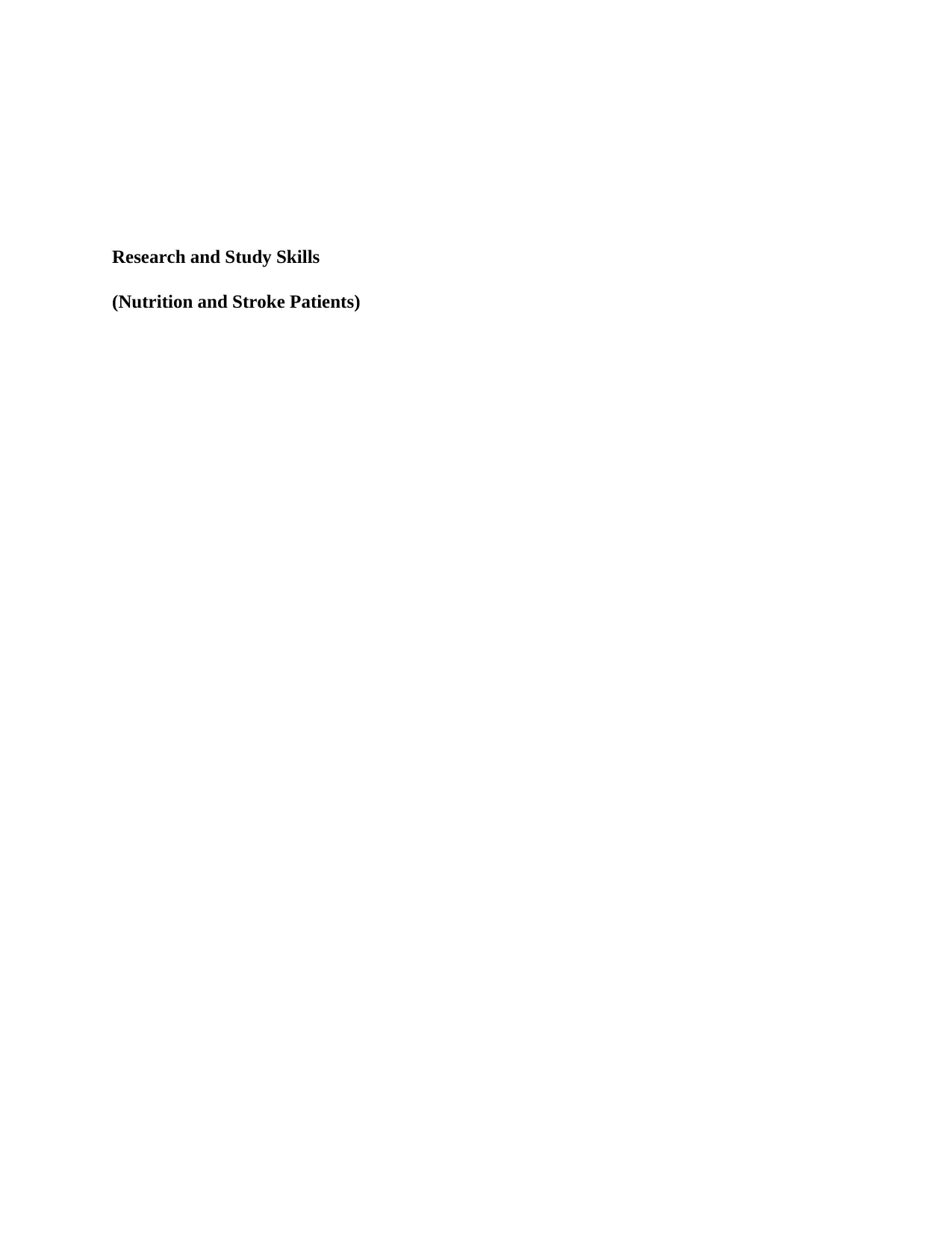
Research and Study Skills
(Nutrition and Stroke Patients)
(Nutrition and Stroke Patients)
Paraphrase This Document
Need a fresh take? Get an instant paraphrase of this document with our AI Paraphraser
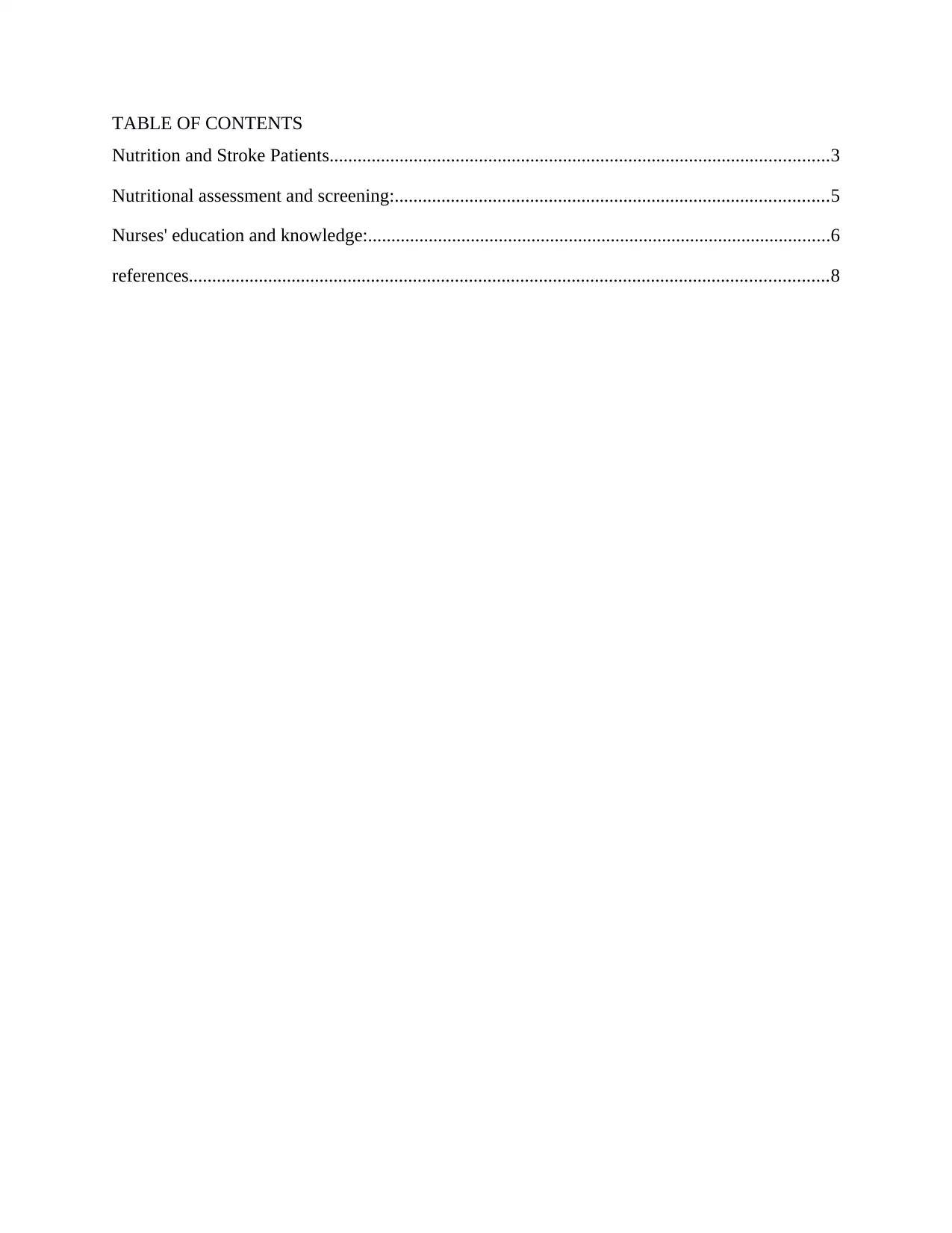
TABLE OF CONTENTS
Nutrition and Stroke Patients...........................................................................................................3
Nutritional assessment and screening:.............................................................................................5
Nurses' education and knowledge:...................................................................................................6
references.........................................................................................................................................8
Nutrition and Stroke Patients...........................................................................................................3
Nutritional assessment and screening:.............................................................................................5
Nurses' education and knowledge:...................................................................................................6
references.........................................................................................................................................8
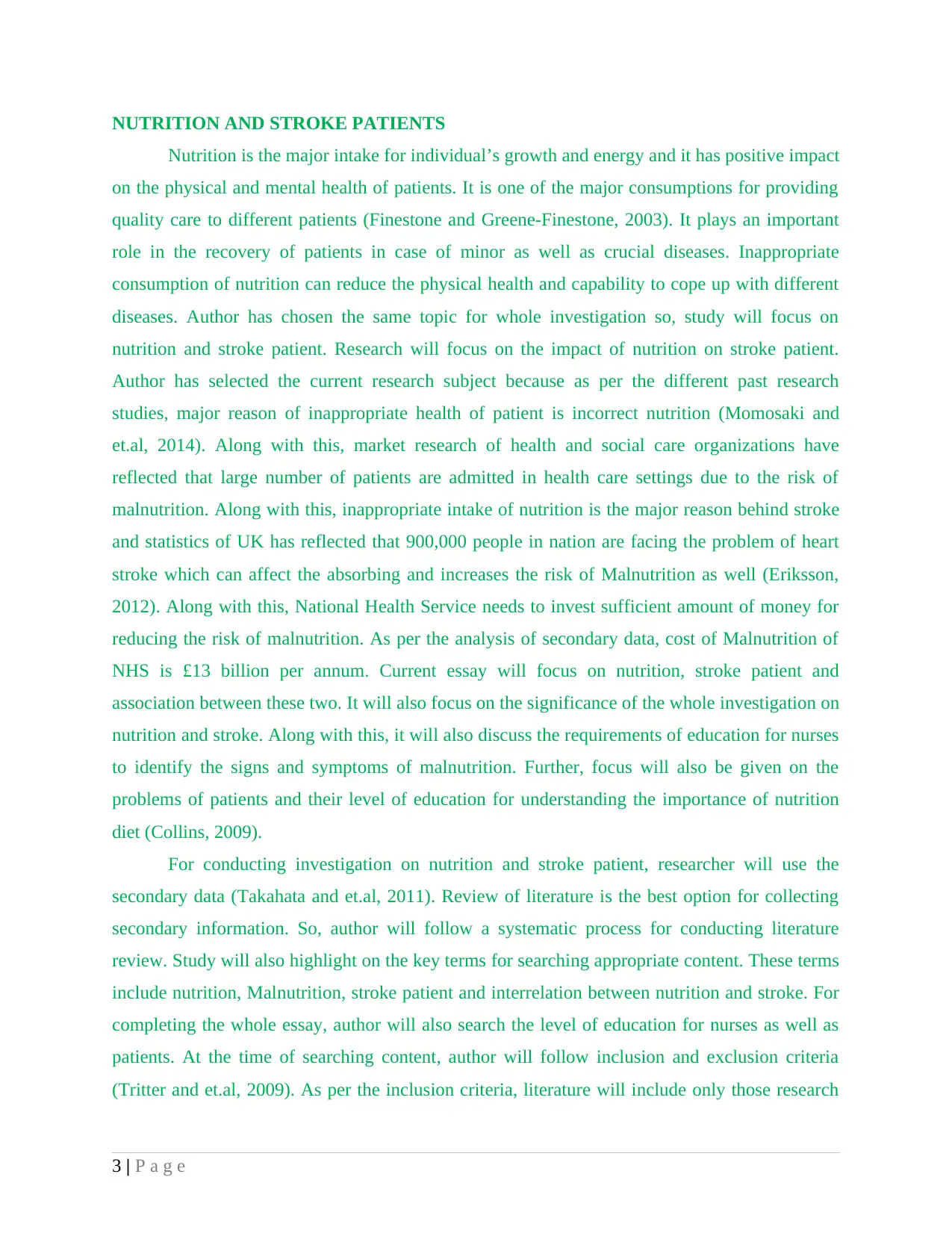
NUTRITION AND STROKE PATIENTS
Nutrition is the major intake for individual’s growth and energy and it has positive impact
on the physical and mental health of patients. It is one of the major consumptions for providing
quality care to different patients (Finestone and Greene-Finestone, 2003). It plays an important
role in the recovery of patients in case of minor as well as crucial diseases. Inappropriate
consumption of nutrition can reduce the physical health and capability to cope up with different
diseases. Author has chosen the same topic for whole investigation so, study will focus on
nutrition and stroke patient. Research will focus on the impact of nutrition on stroke patient.
Author has selected the current research subject because as per the different past research
studies, major reason of inappropriate health of patient is incorrect nutrition (Momosaki and
et.al, 2014). Along with this, market research of health and social care organizations have
reflected that large number of patients are admitted in health care settings due to the risk of
malnutrition. Along with this, inappropriate intake of nutrition is the major reason behind stroke
and statistics of UK has reflected that 900,000 people in nation are facing the problem of heart
stroke which can affect the absorbing and increases the risk of Malnutrition as well (Eriksson,
2012). Along with this, National Health Service needs to invest sufficient amount of money for
reducing the risk of malnutrition. As per the analysis of secondary data, cost of Malnutrition of
NHS is £13 billion per annum. Current essay will focus on nutrition, stroke patient and
association between these two. It will also focus on the significance of the whole investigation on
nutrition and stroke. Along with this, it will also discuss the requirements of education for nurses
to identify the signs and symptoms of malnutrition. Further, focus will also be given on the
problems of patients and their level of education for understanding the importance of nutrition
diet (Collins, 2009).
For conducting investigation on nutrition and stroke patient, researcher will use the
secondary data (Takahata and et.al, 2011). Review of literature is the best option for collecting
secondary information. So, author will follow a systematic process for conducting literature
review. Study will also highlight on the key terms for searching appropriate content. These terms
include nutrition, Malnutrition, stroke patient and interrelation between nutrition and stroke. For
completing the whole essay, author will also search the level of education for nurses as well as
patients. At the time of searching content, author will follow inclusion and exclusion criteria
(Tritter and et.al, 2009). As per the inclusion criteria, literature will include only those research
3 | P a g e
Nutrition is the major intake for individual’s growth and energy and it has positive impact
on the physical and mental health of patients. It is one of the major consumptions for providing
quality care to different patients (Finestone and Greene-Finestone, 2003). It plays an important
role in the recovery of patients in case of minor as well as crucial diseases. Inappropriate
consumption of nutrition can reduce the physical health and capability to cope up with different
diseases. Author has chosen the same topic for whole investigation so, study will focus on
nutrition and stroke patient. Research will focus on the impact of nutrition on stroke patient.
Author has selected the current research subject because as per the different past research
studies, major reason of inappropriate health of patient is incorrect nutrition (Momosaki and
et.al, 2014). Along with this, market research of health and social care organizations have
reflected that large number of patients are admitted in health care settings due to the risk of
malnutrition. Along with this, inappropriate intake of nutrition is the major reason behind stroke
and statistics of UK has reflected that 900,000 people in nation are facing the problem of heart
stroke which can affect the absorbing and increases the risk of Malnutrition as well (Eriksson,
2012). Along with this, National Health Service needs to invest sufficient amount of money for
reducing the risk of malnutrition. As per the analysis of secondary data, cost of Malnutrition of
NHS is £13 billion per annum. Current essay will focus on nutrition, stroke patient and
association between these two. It will also focus on the significance of the whole investigation on
nutrition and stroke. Along with this, it will also discuss the requirements of education for nurses
to identify the signs and symptoms of malnutrition. Further, focus will also be given on the
problems of patients and their level of education for understanding the importance of nutrition
diet (Collins, 2009).
For conducting investigation on nutrition and stroke patient, researcher will use the
secondary data (Takahata and et.al, 2011). Review of literature is the best option for collecting
secondary information. So, author will follow a systematic process for conducting literature
review. Study will also highlight on the key terms for searching appropriate content. These terms
include nutrition, Malnutrition, stroke patient and interrelation between nutrition and stroke. For
completing the whole essay, author will also search the level of education for nurses as well as
patients. At the time of searching content, author will follow inclusion and exclusion criteria
(Tritter and et.al, 2009). As per the inclusion criteria, literature will include only those research
3 | P a g e
⊘ This is a preview!⊘
Do you want full access?
Subscribe today to unlock all pages.

Trusted by 1+ million students worldwide
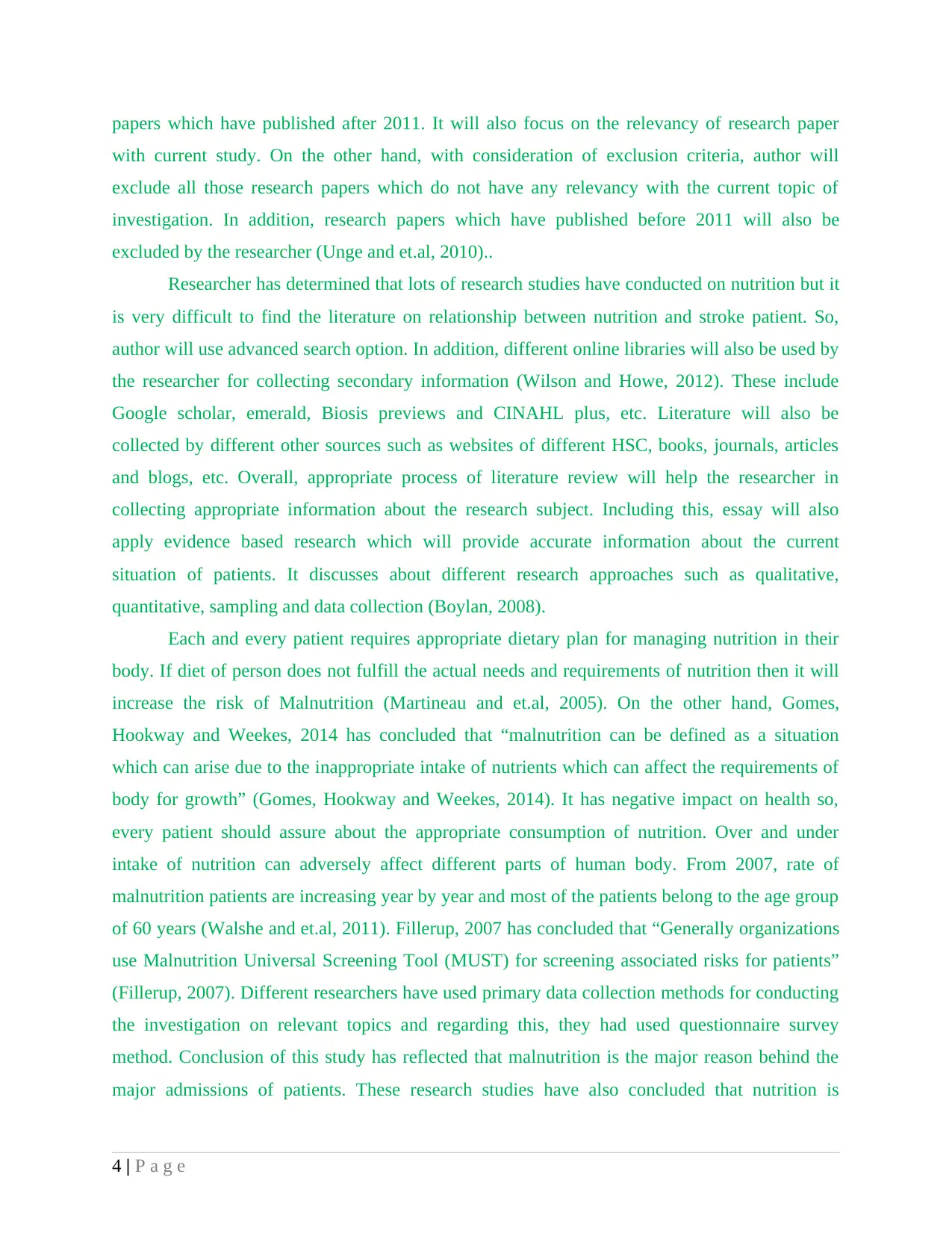
papers which have published after 2011. It will also focus on the relevancy of research paper
with current study. On the other hand, with consideration of exclusion criteria, author will
exclude all those research papers which do not have any relevancy with the current topic of
investigation. In addition, research papers which have published before 2011 will also be
excluded by the researcher (Unge and et.al, 2010)..
Researcher has determined that lots of research studies have conducted on nutrition but it
is very difficult to find the literature on relationship between nutrition and stroke patient. So,
author will use advanced search option. In addition, different online libraries will also be used by
the researcher for collecting secondary information (Wilson and Howe, 2012). These include
Google scholar, emerald, Biosis previews and CINAHL plus, etc. Literature will also be
collected by different other sources such as websites of different HSC, books, journals, articles
and blogs, etc. Overall, appropriate process of literature review will help the researcher in
collecting appropriate information about the research subject. Including this, essay will also
apply evidence based research which will provide accurate information about the current
situation of patients. It discusses about different research approaches such as qualitative,
quantitative, sampling and data collection (Boylan, 2008).
Each and every patient requires appropriate dietary plan for managing nutrition in their
body. If diet of person does not fulfill the actual needs and requirements of nutrition then it will
increase the risk of Malnutrition (Martineau and et.al, 2005). On the other hand, Gomes,
Hookway and Weekes, 2014 has concluded that “malnutrition can be defined as a situation
which can arise due to the inappropriate intake of nutrients which can affect the requirements of
body for growth” (Gomes, Hookway and Weekes, 2014). It has negative impact on health so,
every patient should assure about the appropriate consumption of nutrition. Over and under
intake of nutrition can adversely affect different parts of human body. From 2007, rate of
malnutrition patients are increasing year by year and most of the patients belong to the age group
of 60 years (Walshe and et.al, 2011). Fillerup, 2007 has concluded that “Generally organizations
use Malnutrition Universal Screening Tool (MUST) for screening associated risks for patients”
(Fillerup, 2007). Different researchers have used primary data collection methods for conducting
the investigation on relevant topics and regarding this, they had used questionnaire survey
method. Conclusion of this study has reflected that malnutrition is the major reason behind the
major admissions of patients. These research studies have also concluded that nutrition is
4 | P a g e
with current study. On the other hand, with consideration of exclusion criteria, author will
exclude all those research papers which do not have any relevancy with the current topic of
investigation. In addition, research papers which have published before 2011 will also be
excluded by the researcher (Unge and et.al, 2010)..
Researcher has determined that lots of research studies have conducted on nutrition but it
is very difficult to find the literature on relationship between nutrition and stroke patient. So,
author will use advanced search option. In addition, different online libraries will also be used by
the researcher for collecting secondary information (Wilson and Howe, 2012). These include
Google scholar, emerald, Biosis previews and CINAHL plus, etc. Literature will also be
collected by different other sources such as websites of different HSC, books, journals, articles
and blogs, etc. Overall, appropriate process of literature review will help the researcher in
collecting appropriate information about the research subject. Including this, essay will also
apply evidence based research which will provide accurate information about the current
situation of patients. It discusses about different research approaches such as qualitative,
quantitative, sampling and data collection (Boylan, 2008).
Each and every patient requires appropriate dietary plan for managing nutrition in their
body. If diet of person does not fulfill the actual needs and requirements of nutrition then it will
increase the risk of Malnutrition (Martineau and et.al, 2005). On the other hand, Gomes,
Hookway and Weekes, 2014 has concluded that “malnutrition can be defined as a situation
which can arise due to the inappropriate intake of nutrients which can affect the requirements of
body for growth” (Gomes, Hookway and Weekes, 2014). It has negative impact on health so,
every patient should assure about the appropriate consumption of nutrition. Over and under
intake of nutrition can adversely affect different parts of human body. From 2007, rate of
malnutrition patients are increasing year by year and most of the patients belong to the age group
of 60 years (Walshe and et.al, 2011). Fillerup, 2007 has concluded that “Generally organizations
use Malnutrition Universal Screening Tool (MUST) for screening associated risks for patients”
(Fillerup, 2007). Different researchers have used primary data collection methods for conducting
the investigation on relevant topics and regarding this, they had used questionnaire survey
method. Conclusion of this study has reflected that malnutrition is the major reason behind the
major admissions of patients. These research studies have also concluded that nutrition is
4 | P a g e
Paraphrase This Document
Need a fresh take? Get an instant paraphrase of this document with our AI Paraphraser
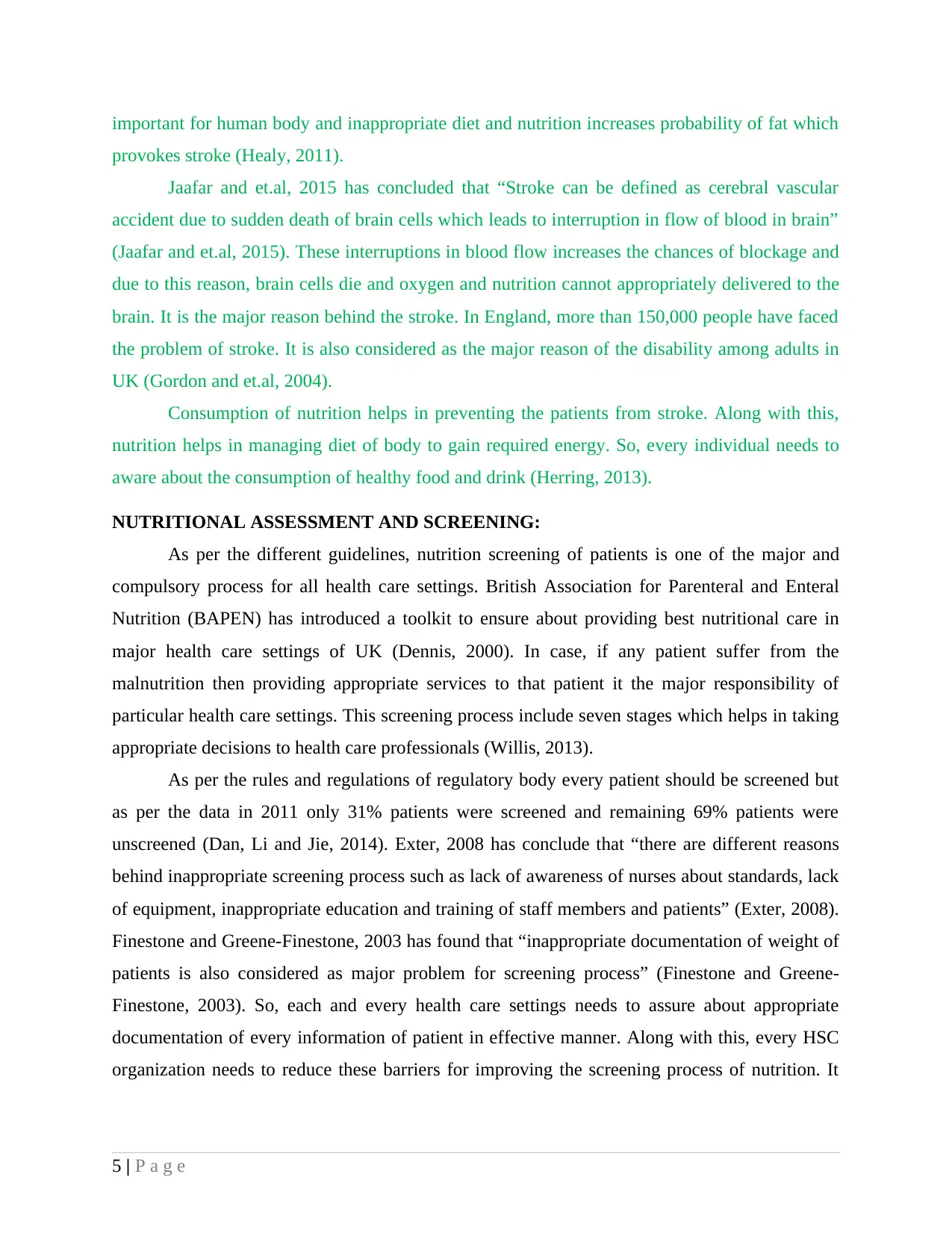
important for human body and inappropriate diet and nutrition increases probability of fat which
provokes stroke (Healy, 2011).
Jaafar and et.al, 2015 has concluded that “Stroke can be defined as cerebral vascular
accident due to sudden death of brain cells which leads to interruption in flow of blood in brain”
(Jaafar and et.al, 2015). These interruptions in blood flow increases the chances of blockage and
due to this reason, brain cells die and oxygen and nutrition cannot appropriately delivered to the
brain. It is the major reason behind the stroke. In England, more than 150,000 people have faced
the problem of stroke. It is also considered as the major reason of the disability among adults in
UK (Gordon and et.al, 2004).
Consumption of nutrition helps in preventing the patients from stroke. Along with this,
nutrition helps in managing diet of body to gain required energy. So, every individual needs to
aware about the consumption of healthy food and drink (Herring, 2013).
NUTRITIONAL ASSESSMENT AND SCREENING:
As per the different guidelines, nutrition screening of patients is one of the major and
compulsory process for all health care settings. British Association for Parenteral and Enteral
Nutrition (BAPEN) has introduced a toolkit to ensure about providing best nutritional care in
major health care settings of UK (Dennis, 2000). In case, if any patient suffer from the
malnutrition then providing appropriate services to that patient it the major responsibility of
particular health care settings. This screening process include seven stages which helps in taking
appropriate decisions to health care professionals (Willis, 2013).
As per the rules and regulations of regulatory body every patient should be screened but
as per the data in 2011 only 31% patients were screened and remaining 69% patients were
unscreened (Dan, Li and Jie, 2014). Exter, 2008 has conclude that “there are different reasons
behind inappropriate screening process such as lack of awareness of nurses about standards, lack
of equipment, inappropriate education and training of staff members and patients” (Exter, 2008).
Finestone and Greene-Finestone, 2003 has found that “inappropriate documentation of weight of
patients is also considered as major problem for screening process” (Finestone and Greene-
Finestone, 2003). So, each and every health care settings needs to assure about appropriate
documentation of every information of patient in effective manner. Along with this, every HSC
organization needs to reduce these barriers for improving the screening process of nutrition. It
5 | P a g e
provokes stroke (Healy, 2011).
Jaafar and et.al, 2015 has concluded that “Stroke can be defined as cerebral vascular
accident due to sudden death of brain cells which leads to interruption in flow of blood in brain”
(Jaafar and et.al, 2015). These interruptions in blood flow increases the chances of blockage and
due to this reason, brain cells die and oxygen and nutrition cannot appropriately delivered to the
brain. It is the major reason behind the stroke. In England, more than 150,000 people have faced
the problem of stroke. It is also considered as the major reason of the disability among adults in
UK (Gordon and et.al, 2004).
Consumption of nutrition helps in preventing the patients from stroke. Along with this,
nutrition helps in managing diet of body to gain required energy. So, every individual needs to
aware about the consumption of healthy food and drink (Herring, 2013).
NUTRITIONAL ASSESSMENT AND SCREENING:
As per the different guidelines, nutrition screening of patients is one of the major and
compulsory process for all health care settings. British Association for Parenteral and Enteral
Nutrition (BAPEN) has introduced a toolkit to ensure about providing best nutritional care in
major health care settings of UK (Dennis, 2000). In case, if any patient suffer from the
malnutrition then providing appropriate services to that patient it the major responsibility of
particular health care settings. This screening process include seven stages which helps in taking
appropriate decisions to health care professionals (Willis, 2013).
As per the rules and regulations of regulatory body every patient should be screened but
as per the data in 2011 only 31% patients were screened and remaining 69% patients were
unscreened (Dan, Li and Jie, 2014). Exter, 2008 has conclude that “there are different reasons
behind inappropriate screening process such as lack of awareness of nurses about standards, lack
of equipment, inappropriate education and training of staff members and patients” (Exter, 2008).
Finestone and Greene-Finestone, 2003 has found that “inappropriate documentation of weight of
patients is also considered as major problem for screening process” (Finestone and Greene-
Finestone, 2003). So, each and every health care settings needs to assure about appropriate
documentation of every information of patient in effective manner. Along with this, every HSC
organization needs to reduce these barriers for improving the screening process of nutrition. It
5 | P a g e
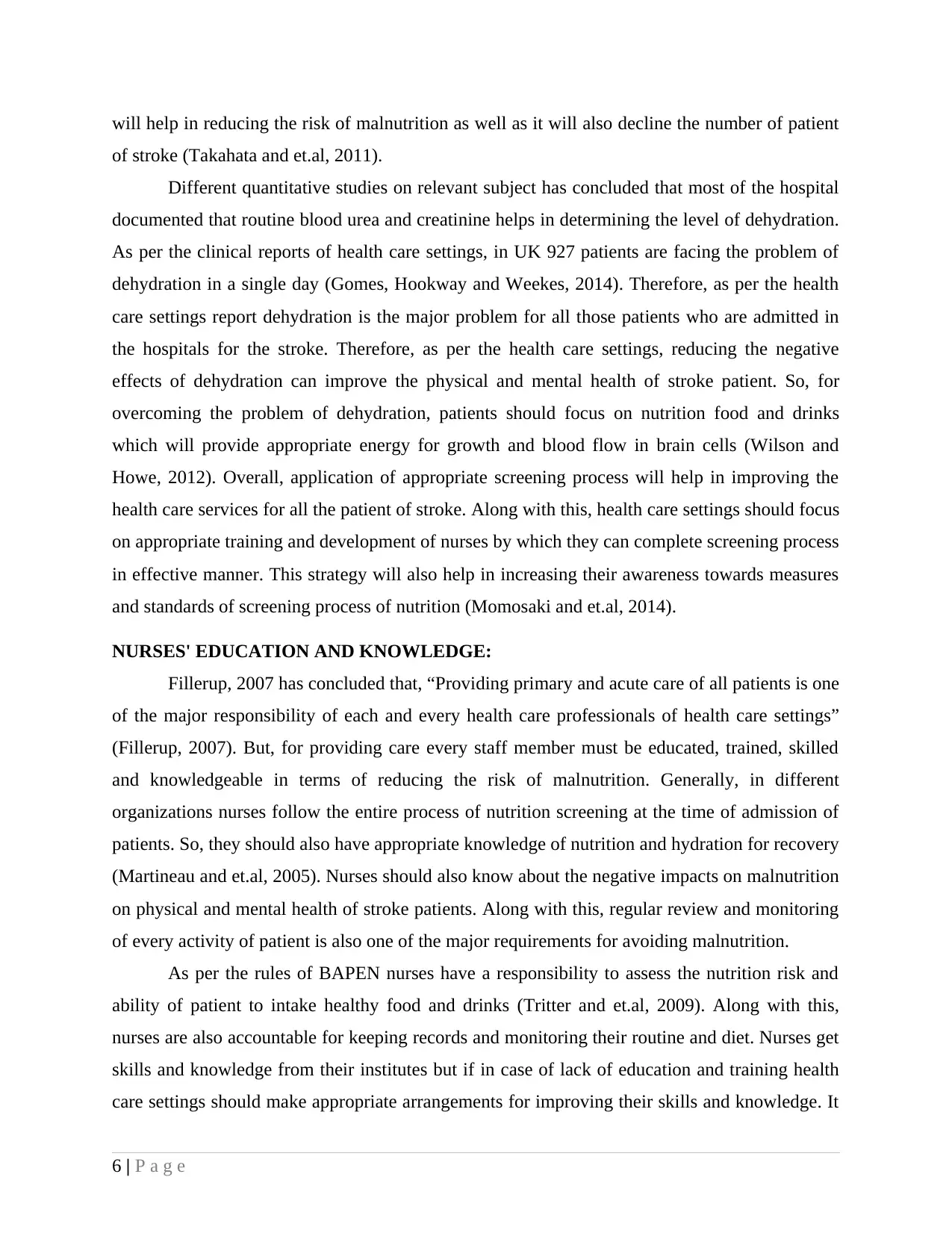
will help in reducing the risk of malnutrition as well as it will also decline the number of patient
of stroke (Takahata and et.al, 2011).
Different quantitative studies on relevant subject has concluded that most of the hospital
documented that routine blood urea and creatinine helps in determining the level of dehydration.
As per the clinical reports of health care settings, in UK 927 patients are facing the problem of
dehydration in a single day (Gomes, Hookway and Weekes, 2014). Therefore, as per the health
care settings report dehydration is the major problem for all those patients who are admitted in
the hospitals for the stroke. Therefore, as per the health care settings, reducing the negative
effects of dehydration can improve the physical and mental health of stroke patient. So, for
overcoming the problem of dehydration, patients should focus on nutrition food and drinks
which will provide appropriate energy for growth and blood flow in brain cells (Wilson and
Howe, 2012). Overall, application of appropriate screening process will help in improving the
health care services for all the patient of stroke. Along with this, health care settings should focus
on appropriate training and development of nurses by which they can complete screening process
in effective manner. This strategy will also help in increasing their awareness towards measures
and standards of screening process of nutrition (Momosaki and et.al, 2014).
NURSES' EDUCATION AND KNOWLEDGE:
Fillerup, 2007 has concluded that, “Providing primary and acute care of all patients is one
of the major responsibility of each and every health care professionals of health care settings”
(Fillerup, 2007). But, for providing care every staff member must be educated, trained, skilled
and knowledgeable in terms of reducing the risk of malnutrition. Generally, in different
organizations nurses follow the entire process of nutrition screening at the time of admission of
patients. So, they should also have appropriate knowledge of nutrition and hydration for recovery
(Martineau and et.al, 2005). Nurses should also know about the negative impacts on malnutrition
on physical and mental health of stroke patients. Along with this, regular review and monitoring
of every activity of patient is also one of the major requirements for avoiding malnutrition.
As per the rules of BAPEN nurses have a responsibility to assess the nutrition risk and
ability of patient to intake healthy food and drinks (Tritter and et.al, 2009). Along with this,
nurses are also accountable for keeping records and monitoring their routine and diet. Nurses get
skills and knowledge from their institutes but if in case of lack of education and training health
care settings should make appropriate arrangements for improving their skills and knowledge. It
6 | P a g e
of stroke (Takahata and et.al, 2011).
Different quantitative studies on relevant subject has concluded that most of the hospital
documented that routine blood urea and creatinine helps in determining the level of dehydration.
As per the clinical reports of health care settings, in UK 927 patients are facing the problem of
dehydration in a single day (Gomes, Hookway and Weekes, 2014). Therefore, as per the health
care settings report dehydration is the major problem for all those patients who are admitted in
the hospitals for the stroke. Therefore, as per the health care settings, reducing the negative
effects of dehydration can improve the physical and mental health of stroke patient. So, for
overcoming the problem of dehydration, patients should focus on nutrition food and drinks
which will provide appropriate energy for growth and blood flow in brain cells (Wilson and
Howe, 2012). Overall, application of appropriate screening process will help in improving the
health care services for all the patient of stroke. Along with this, health care settings should focus
on appropriate training and development of nurses by which they can complete screening process
in effective manner. This strategy will also help in increasing their awareness towards measures
and standards of screening process of nutrition (Momosaki and et.al, 2014).
NURSES' EDUCATION AND KNOWLEDGE:
Fillerup, 2007 has concluded that, “Providing primary and acute care of all patients is one
of the major responsibility of each and every health care professionals of health care settings”
(Fillerup, 2007). But, for providing care every staff member must be educated, trained, skilled
and knowledgeable in terms of reducing the risk of malnutrition. Generally, in different
organizations nurses follow the entire process of nutrition screening at the time of admission of
patients. So, they should also have appropriate knowledge of nutrition and hydration for recovery
(Martineau and et.al, 2005). Nurses should also know about the negative impacts on malnutrition
on physical and mental health of stroke patients. Along with this, regular review and monitoring
of every activity of patient is also one of the major requirements for avoiding malnutrition.
As per the rules of BAPEN nurses have a responsibility to assess the nutrition risk and
ability of patient to intake healthy food and drinks (Tritter and et.al, 2009). Along with this,
nurses are also accountable for keeping records and monitoring their routine and diet. Nurses get
skills and knowledge from their institutes but if in case of lack of education and training health
care settings should make appropriate arrangements for improving their skills and knowledge. It
6 | P a g e
⊘ This is a preview!⊘
Do you want full access?
Subscribe today to unlock all pages.

Trusted by 1+ million students worldwide
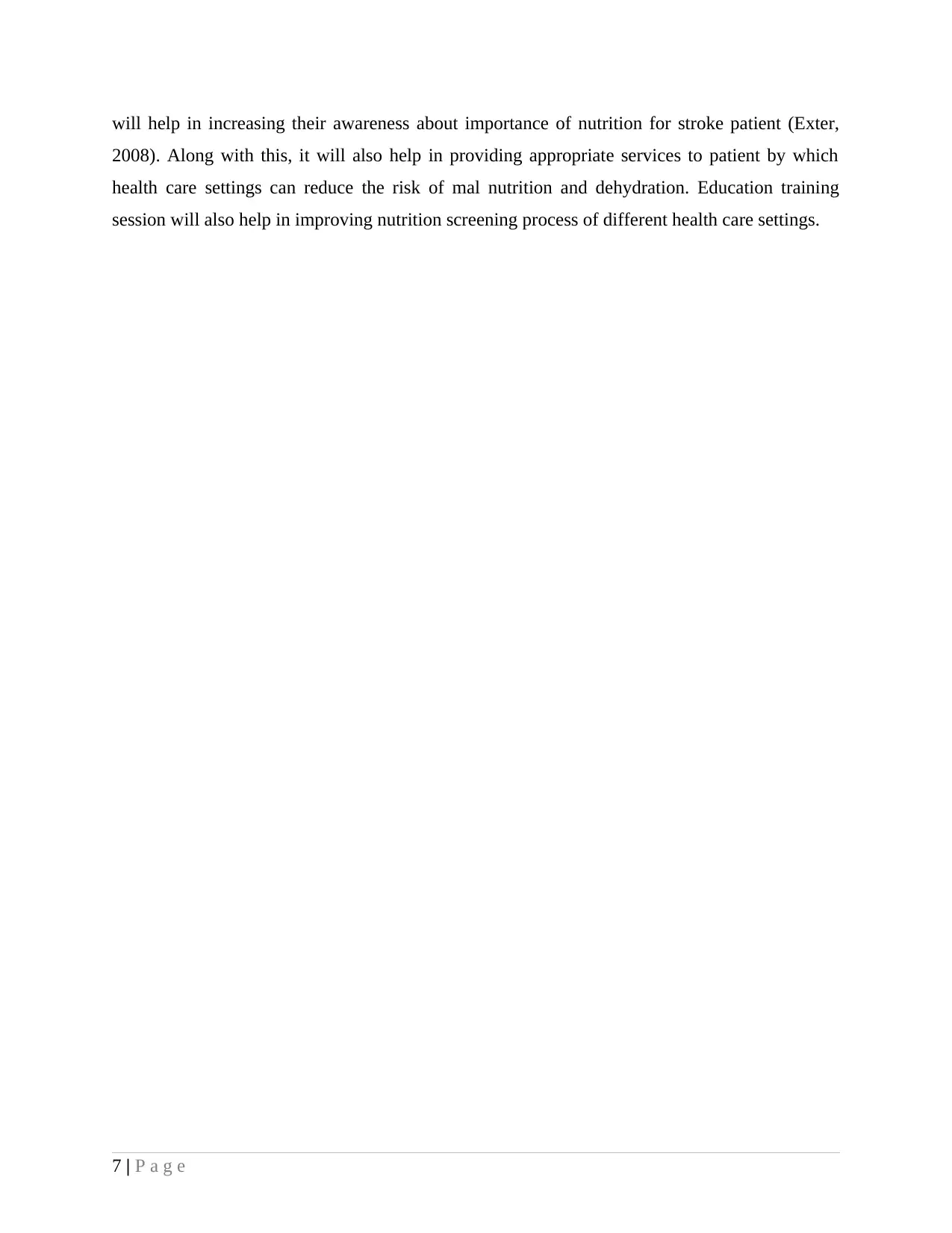
will help in increasing their awareness about importance of nutrition for stroke patient (Exter,
2008). Along with this, it will also help in providing appropriate services to patient by which
health care settings can reduce the risk of mal nutrition and dehydration. Education training
session will also help in improving nutrition screening process of different health care settings.
7 | P a g e
2008). Along with this, it will also help in providing appropriate services to patient by which
health care settings can reduce the risk of mal nutrition and dehydration. Education training
session will also help in improving nutrition screening process of different health care settings.
7 | P a g e
Paraphrase This Document
Need a fresh take? Get an instant paraphrase of this document with our AI Paraphraser
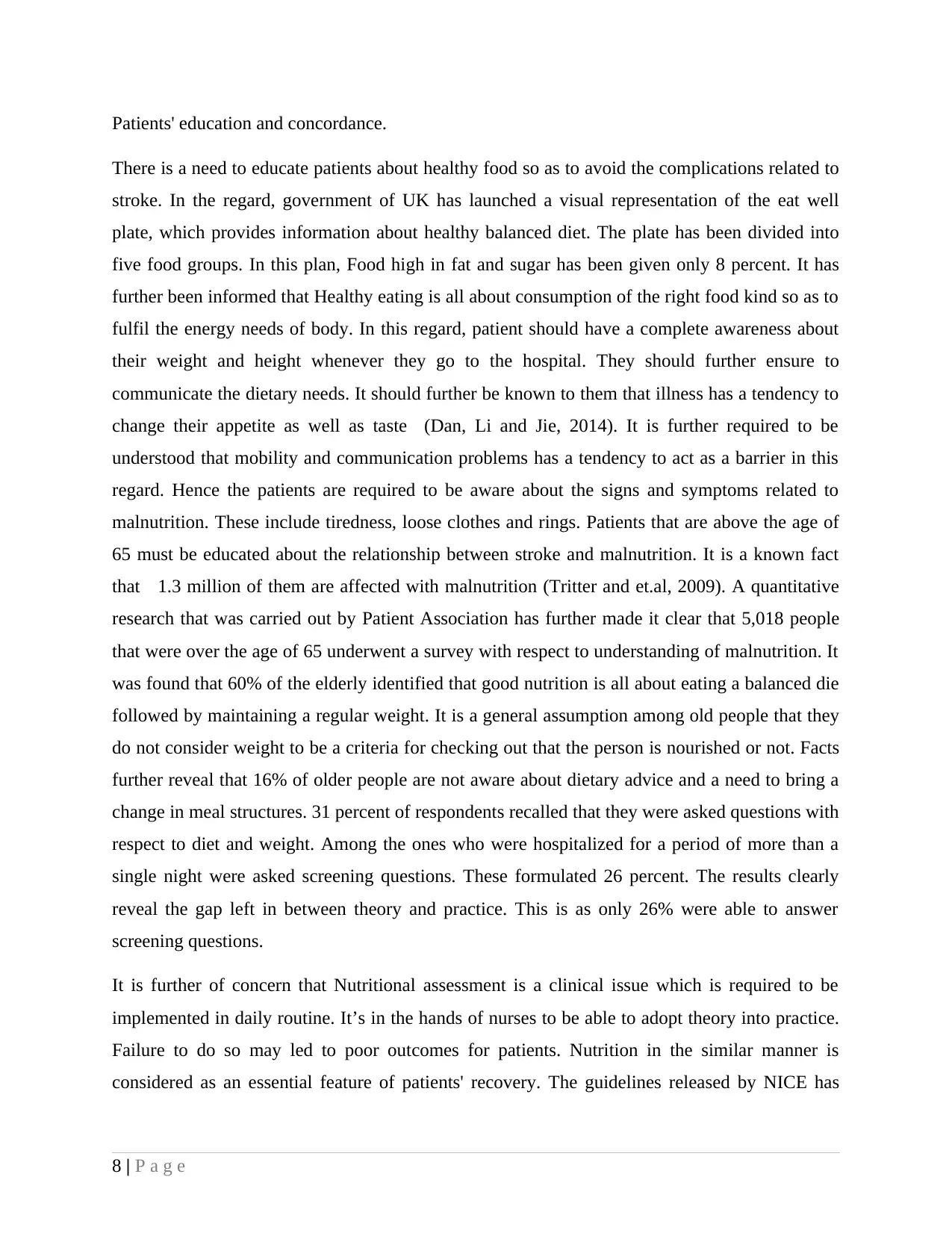
Patients' education and concordance.
There is a need to educate patients about healthy food so as to avoid the complications related to
stroke. In the regard, government of UK has launched a visual representation of the eat well
plate, which provides information about healthy balanced diet. The plate has been divided into
five food groups. In this plan, Food high in fat and sugar has been given only 8 percent. It has
further been informed that Healthy eating is all about consumption of the right food kind so as to
fulfil the energy needs of body. In this regard, patient should have a complete awareness about
their weight and height whenever they go to the hospital. They should further ensure to
communicate the dietary needs. It should further be known to them that illness has a tendency to
change their appetite as well as taste (Dan, Li and Jie, 2014). It is further required to be
understood that mobility and communication problems has a tendency to act as a barrier in this
regard. Hence the patients are required to be aware about the signs and symptoms related to
malnutrition. These include tiredness, loose clothes and rings. Patients that are above the age of
65 must be educated about the relationship between stroke and malnutrition. It is a known fact
that 1.3 million of them are affected with malnutrition (Tritter and et.al, 2009). A quantitative
research that was carried out by Patient Association has further made it clear that 5,018 people
that were over the age of 65 underwent a survey with respect to understanding of malnutrition. It
was found that 60% of the elderly identified that good nutrition is all about eating a balanced die
followed by maintaining a regular weight. It is a general assumption among old people that they
do not consider weight to be a criteria for checking out that the person is nourished or not. Facts
further reveal that 16% of older people are not aware about dietary advice and a need to bring a
change in meal structures. 31 percent of respondents recalled that they were asked questions with
respect to diet and weight. Among the ones who were hospitalized for a period of more than a
single night were asked screening questions. These formulated 26 percent. The results clearly
reveal the gap left in between theory and practice. This is as only 26% were able to answer
screening questions.
It is further of concern that Nutritional assessment is a clinical issue which is required to be
implemented in daily routine. It’s in the hands of nurses to be able to adopt theory into practice.
Failure to do so may led to poor outcomes for patients. Nutrition in the similar manner is
considered as an essential feature of patients' recovery. The guidelines released by NICE has
8 | P a g e
There is a need to educate patients about healthy food so as to avoid the complications related to
stroke. In the regard, government of UK has launched a visual representation of the eat well
plate, which provides information about healthy balanced diet. The plate has been divided into
five food groups. In this plan, Food high in fat and sugar has been given only 8 percent. It has
further been informed that Healthy eating is all about consumption of the right food kind so as to
fulfil the energy needs of body. In this regard, patient should have a complete awareness about
their weight and height whenever they go to the hospital. They should further ensure to
communicate the dietary needs. It should further be known to them that illness has a tendency to
change their appetite as well as taste (Dan, Li and Jie, 2014). It is further required to be
understood that mobility and communication problems has a tendency to act as a barrier in this
regard. Hence the patients are required to be aware about the signs and symptoms related to
malnutrition. These include tiredness, loose clothes and rings. Patients that are above the age of
65 must be educated about the relationship between stroke and malnutrition. It is a known fact
that 1.3 million of them are affected with malnutrition (Tritter and et.al, 2009). A quantitative
research that was carried out by Patient Association has further made it clear that 5,018 people
that were over the age of 65 underwent a survey with respect to understanding of malnutrition. It
was found that 60% of the elderly identified that good nutrition is all about eating a balanced die
followed by maintaining a regular weight. It is a general assumption among old people that they
do not consider weight to be a criteria for checking out that the person is nourished or not. Facts
further reveal that 16% of older people are not aware about dietary advice and a need to bring a
change in meal structures. 31 percent of respondents recalled that they were asked questions with
respect to diet and weight. Among the ones who were hospitalized for a period of more than a
single night were asked screening questions. These formulated 26 percent. The results clearly
reveal the gap left in between theory and practice. This is as only 26% were able to answer
screening questions.
It is further of concern that Nutritional assessment is a clinical issue which is required to be
implemented in daily routine. It’s in the hands of nurses to be able to adopt theory into practice.
Failure to do so may led to poor outcomes for patients. Nutrition in the similar manner is
considered as an essential feature of patients' recovery. The guidelines released by NICE has
8 | P a g e
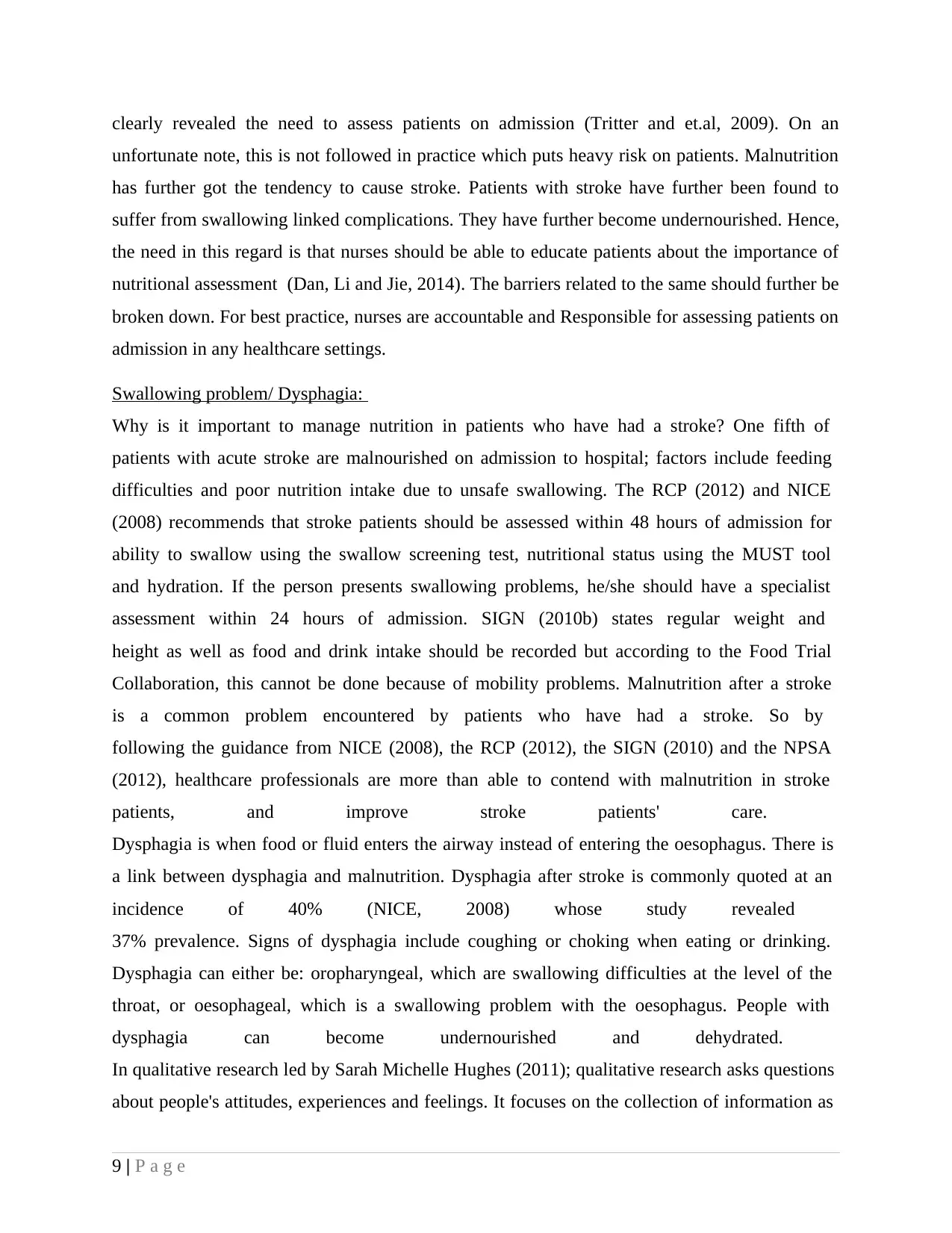
clearly revealed the need to assess patients on admission (Tritter and et.al, 2009). On an
unfortunate note, this is not followed in practice which puts heavy risk on patients. Malnutrition
has further got the tendency to cause stroke. Patients with stroke have further been found to
suffer from swallowing linked complications. They have further become undernourished. Hence,
the need in this regard is that nurses should be able to educate patients about the importance of
nutritional assessment (Dan, Li and Jie, 2014). The barriers related to the same should further be
broken down. For best practice, nurses are accountable and Responsible for assessing patients on
admission in any healthcare settings.
Swallowing problem/ Dysphagia:
Why is it important to manage nutrition in patients who have had a stroke? One fifth of
patients with acute stroke are malnourished on admission to hospital; factors include feeding
difficulties and poor nutrition intake due to unsafe swallowing. The RCP (2012) and NICE
(2008) recommends that stroke patients should be assessed within 48 hours of admission for
ability to swallow using the swallow screening test, nutritional status using the MUST tool
and hydration. If the person presents swallowing problems, he/she should have a specialist
assessment within 24 hours of admission. SIGN (2010b) states regular weight and
height as well as food and drink intake should be recorded but according to the Food Trial
Collaboration, this cannot be done because of mobility problems. Malnutrition after a stroke
is a common problem encountered by patients who have had a stroke. So by
following the guidance from NICE (2008), the RCP (2012), the SIGN (2010) and the NPSA
(2012), healthcare professionals are more than able to contend with malnutrition in stroke
patients, and improve stroke patients' care.
Dysphagia is when food or fluid enters the airway instead of entering the oesophagus. There is
a link between dysphagia and malnutrition. Dysphagia after stroke is commonly quoted at an
incidence of 40% (NICE, 2008) whose study revealed
37% prevalence. Signs of dysphagia include coughing or choking when eating or drinking.
Dysphagia can either be: oropharyngeal, which are swallowing difficulties at the level of the
throat, or oesophageal, which is a swallowing problem with the oesophagus. People with
dysphagia can become undernourished and dehydrated.
In qualitative research led by Sarah Michelle Hughes (2011); qualitative research asks questions
about people's attitudes, experiences and feelings. It focuses on the collection of information as
9 | P a g e
unfortunate note, this is not followed in practice which puts heavy risk on patients. Malnutrition
has further got the tendency to cause stroke. Patients with stroke have further been found to
suffer from swallowing linked complications. They have further become undernourished. Hence,
the need in this regard is that nurses should be able to educate patients about the importance of
nutritional assessment (Dan, Li and Jie, 2014). The barriers related to the same should further be
broken down. For best practice, nurses are accountable and Responsible for assessing patients on
admission in any healthcare settings.
Swallowing problem/ Dysphagia:
Why is it important to manage nutrition in patients who have had a stroke? One fifth of
patients with acute stroke are malnourished on admission to hospital; factors include feeding
difficulties and poor nutrition intake due to unsafe swallowing. The RCP (2012) and NICE
(2008) recommends that stroke patients should be assessed within 48 hours of admission for
ability to swallow using the swallow screening test, nutritional status using the MUST tool
and hydration. If the person presents swallowing problems, he/she should have a specialist
assessment within 24 hours of admission. SIGN (2010b) states regular weight and
height as well as food and drink intake should be recorded but according to the Food Trial
Collaboration, this cannot be done because of mobility problems. Malnutrition after a stroke
is a common problem encountered by patients who have had a stroke. So by
following the guidance from NICE (2008), the RCP (2012), the SIGN (2010) and the NPSA
(2012), healthcare professionals are more than able to contend with malnutrition in stroke
patients, and improve stroke patients' care.
Dysphagia is when food or fluid enters the airway instead of entering the oesophagus. There is
a link between dysphagia and malnutrition. Dysphagia after stroke is commonly quoted at an
incidence of 40% (NICE, 2008) whose study revealed
37% prevalence. Signs of dysphagia include coughing or choking when eating or drinking.
Dysphagia can either be: oropharyngeal, which are swallowing difficulties at the level of the
throat, or oesophageal, which is a swallowing problem with the oesophagus. People with
dysphagia can become undernourished and dehydrated.
In qualitative research led by Sarah Michelle Hughes (2011); qualitative research asks questions
about people's attitudes, experiences and feelings. It focuses on the collection of information as
9 | P a g e
⊘ This is a preview!⊘
Do you want full access?
Subscribe today to unlock all pages.

Trusted by 1+ million students worldwide
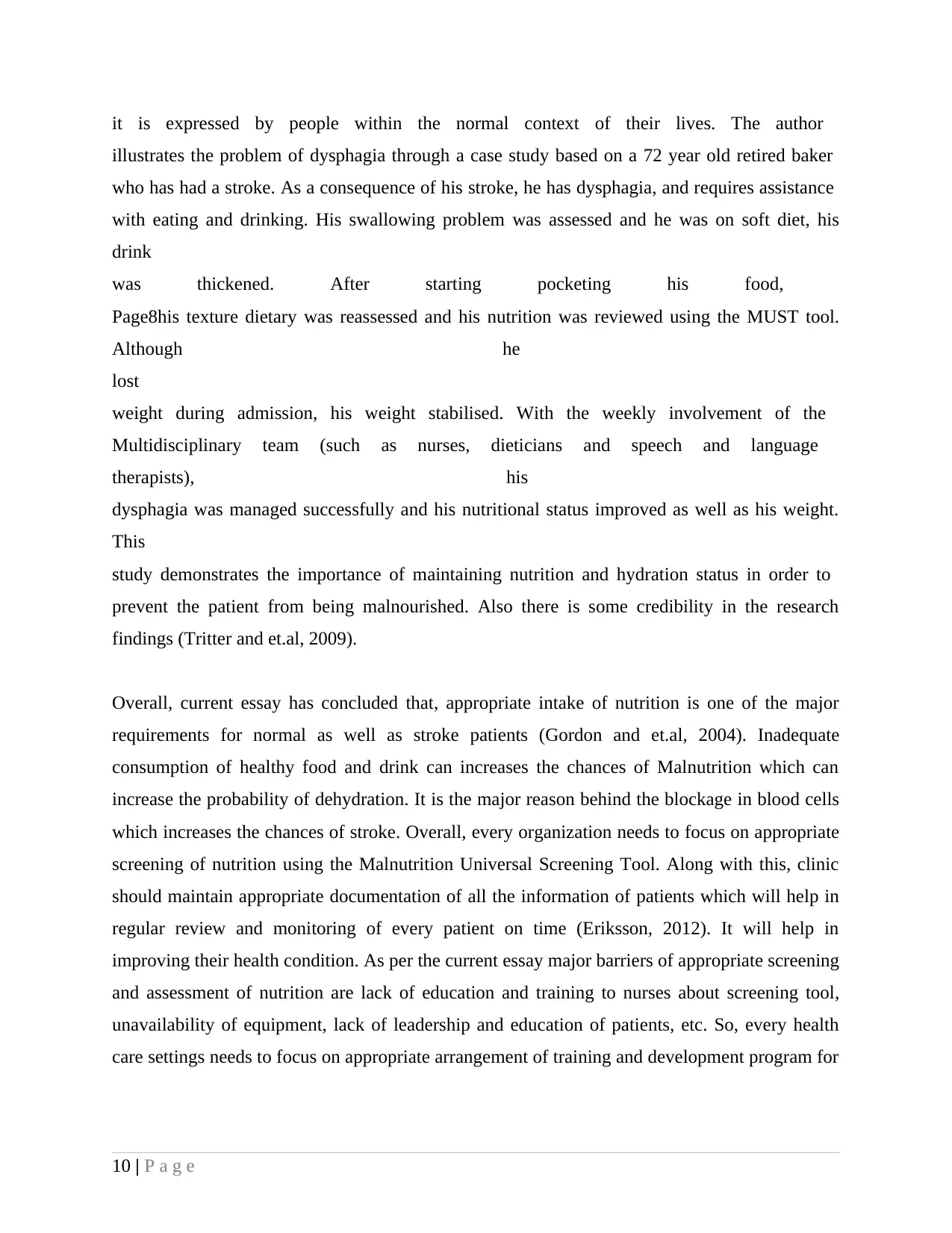
it is expressed by people within the normal context of their lives. The author
illustrates the problem of dysphagia through a case study based on a 72 year old retired baker
who has had a stroke. As a consequence of his stroke, he has dysphagia, and requires assistance
with eating and drinking. His swallowing problem was assessed and he was on soft diet, his
drink
was thickened. After starting pocketing his food,
Page8his texture dietary was reassessed and his nutrition was reviewed using the MUST tool.
Although he
lost
weight during admission, his weight stabilised. With the weekly involvement of the
Multidisciplinary team (such as nurses, dieticians and speech and language
therapists), his
dysphagia was managed successfully and his nutritional status improved as well as his weight.
This
study demonstrates the importance of maintaining nutrition and hydration status in order to
prevent the patient from being malnourished. Also there is some credibility in the research
findings (Tritter and et.al, 2009).
Overall, current essay has concluded that, appropriate intake of nutrition is one of the major
requirements for normal as well as stroke patients (Gordon and et.al, 2004). Inadequate
consumption of healthy food and drink can increases the chances of Malnutrition which can
increase the probability of dehydration. It is the major reason behind the blockage in blood cells
which increases the chances of stroke. Overall, every organization needs to focus on appropriate
screening of nutrition using the Malnutrition Universal Screening Tool. Along with this, clinic
should maintain appropriate documentation of all the information of patients which will help in
regular review and monitoring of every patient on time (Eriksson, 2012). It will help in
improving their health condition. As per the current essay major barriers of appropriate screening
and assessment of nutrition are lack of education and training to nurses about screening tool,
unavailability of equipment, lack of leadership and education of patients, etc. So, every health
care settings needs to focus on appropriate arrangement of training and development program for
10 | P a g e
illustrates the problem of dysphagia through a case study based on a 72 year old retired baker
who has had a stroke. As a consequence of his stroke, he has dysphagia, and requires assistance
with eating and drinking. His swallowing problem was assessed and he was on soft diet, his
drink
was thickened. After starting pocketing his food,
Page8his texture dietary was reassessed and his nutrition was reviewed using the MUST tool.
Although he
lost
weight during admission, his weight stabilised. With the weekly involvement of the
Multidisciplinary team (such as nurses, dieticians and speech and language
therapists), his
dysphagia was managed successfully and his nutritional status improved as well as his weight.
This
study demonstrates the importance of maintaining nutrition and hydration status in order to
prevent the patient from being malnourished. Also there is some credibility in the research
findings (Tritter and et.al, 2009).
Overall, current essay has concluded that, appropriate intake of nutrition is one of the major
requirements for normal as well as stroke patients (Gordon and et.al, 2004). Inadequate
consumption of healthy food and drink can increases the chances of Malnutrition which can
increase the probability of dehydration. It is the major reason behind the blockage in blood cells
which increases the chances of stroke. Overall, every organization needs to focus on appropriate
screening of nutrition using the Malnutrition Universal Screening Tool. Along with this, clinic
should maintain appropriate documentation of all the information of patients which will help in
regular review and monitoring of every patient on time (Eriksson, 2012). It will help in
improving their health condition. As per the current essay major barriers of appropriate screening
and assessment of nutrition are lack of education and training to nurses about screening tool,
unavailability of equipment, lack of leadership and education of patients, etc. So, every health
care settings needs to focus on appropriate arrangement of training and development program for
10 | P a g e
Paraphrase This Document
Need a fresh take? Get an instant paraphrase of this document with our AI Paraphraser
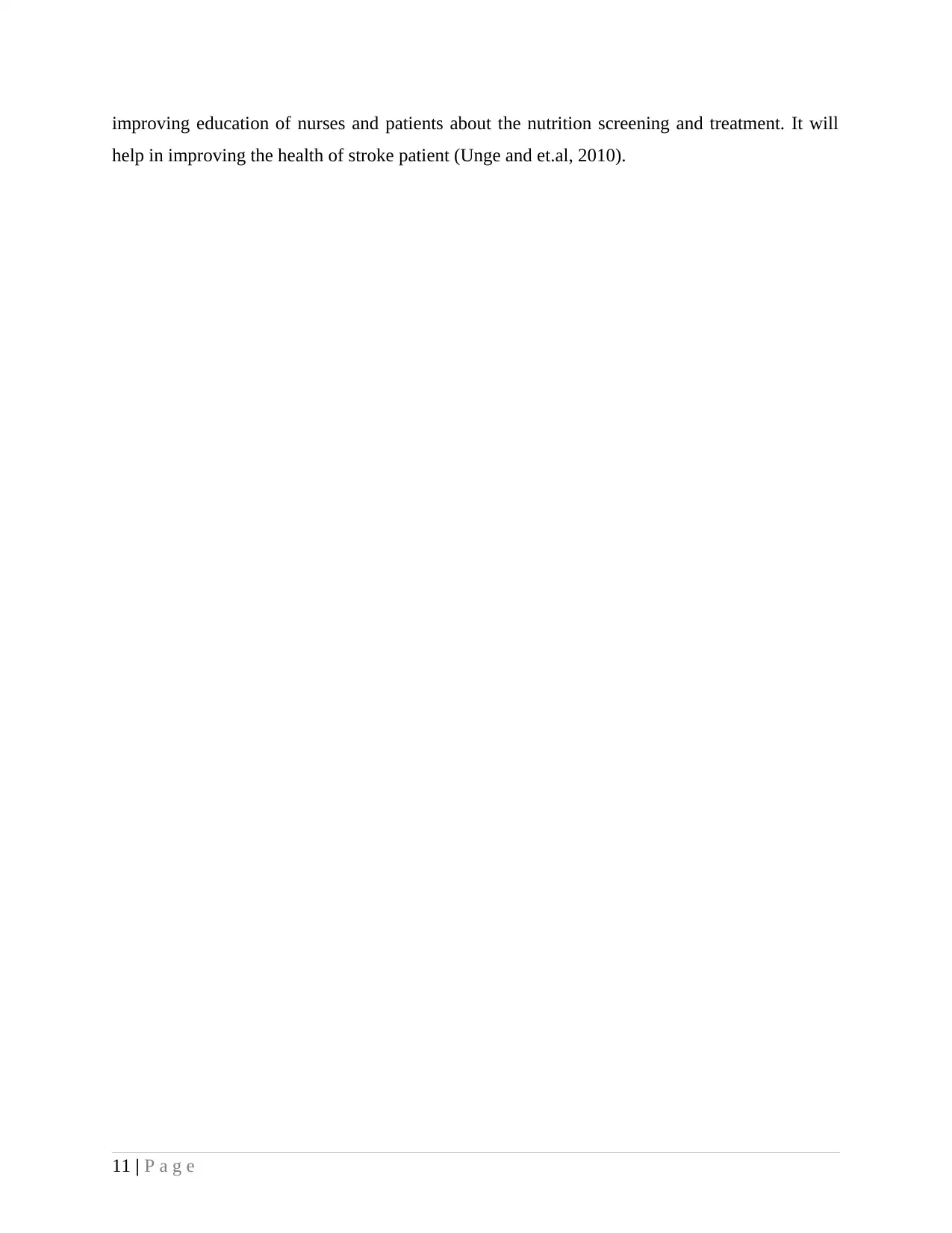
improving education of nurses and patients about the nutrition screening and treatment. It will
help in improving the health of stroke patient (Unge and et.al, 2010).
11 | P a g e
help in improving the health of stroke patient (Unge and et.al, 2010).
11 | P a g e
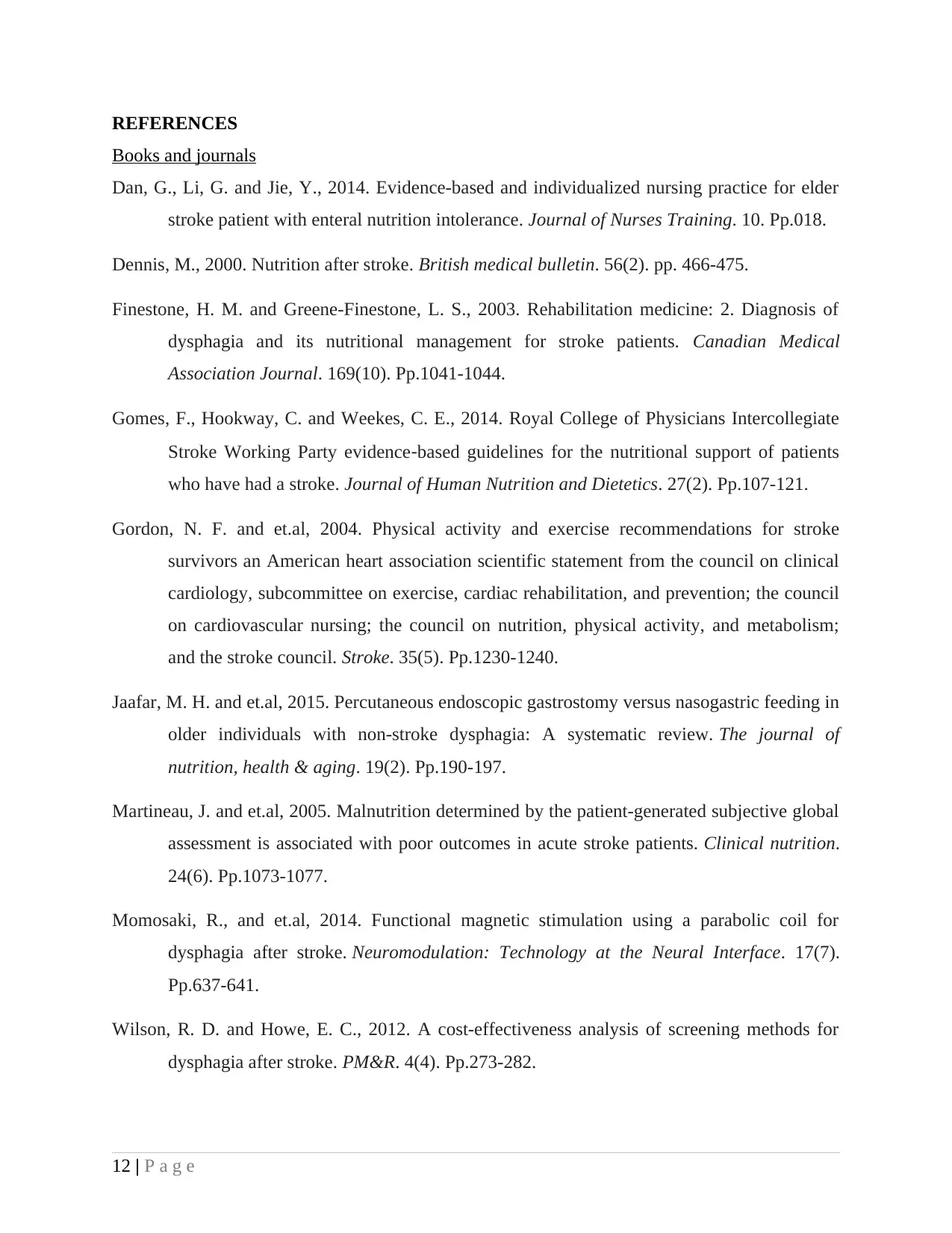
REFERENCES
Books and journals
Dan, G., Li, G. and Jie, Y., 2014. Evidence-based and individualized nursing practice for elder
stroke patient with enteral nutrition intolerance. Journal of Nurses Training. 10. Pp.018.
Dennis, M., 2000. Nutrition after stroke. British medical bulletin. 56(2). pp. 466-475.
Finestone, H. M. and Greene-Finestone, L. S., 2003. Rehabilitation medicine: 2. Diagnosis of
dysphagia and its nutritional management for stroke patients. Canadian Medical
Association Journal. 169(10). Pp.1041-1044.
Gomes, F., Hookway, C. and Weekes, C. E., 2014. Royal College of Physicians Intercollegiate
Stroke Working Party evidence‐based guidelines for the nutritional support of patients
who have had a stroke. Journal of Human Nutrition and Dietetics. 27(2). Pp.107-121.
Gordon, N. F. and et.al, 2004. Physical activity and exercise recommendations for stroke
survivors an American heart association scientific statement from the council on clinical
cardiology, subcommittee on exercise, cardiac rehabilitation, and prevention; the council
on cardiovascular nursing; the council on nutrition, physical activity, and metabolism;
and the stroke council. Stroke. 35(5). Pp.1230-1240.
Jaafar, M. H. and et.al, 2015. Percutaneous endoscopic gastrostomy versus nasogastric feeding in
older individuals with non-stroke dysphagia: A systematic review. The journal of
nutrition, health & aging. 19(2). Pp.190-197.
Martineau, J. and et.al, 2005. Malnutrition determined by the patient-generated subjective global
assessment is associated with poor outcomes in acute stroke patients. Clinical nutrition.
24(6). Pp.1073-1077.
Momosaki, R., and et.al, 2014. Functional magnetic stimulation using a parabolic coil for
dysphagia after stroke. Neuromodulation: Technology at the Neural Interface. 17(7).
Pp.637-641.
Wilson, R. D. and Howe, E. C., 2012. A cost-effectiveness analysis of screening methods for
dysphagia after stroke. PM&R. 4(4). Pp.273-282.
12 | P a g e
Books and journals
Dan, G., Li, G. and Jie, Y., 2014. Evidence-based and individualized nursing practice for elder
stroke patient with enteral nutrition intolerance. Journal of Nurses Training. 10. Pp.018.
Dennis, M., 2000. Nutrition after stroke. British medical bulletin. 56(2). pp. 466-475.
Finestone, H. M. and Greene-Finestone, L. S., 2003. Rehabilitation medicine: 2. Diagnosis of
dysphagia and its nutritional management for stroke patients. Canadian Medical
Association Journal. 169(10). Pp.1041-1044.
Gomes, F., Hookway, C. and Weekes, C. E., 2014. Royal College of Physicians Intercollegiate
Stroke Working Party evidence‐based guidelines for the nutritional support of patients
who have had a stroke. Journal of Human Nutrition and Dietetics. 27(2). Pp.107-121.
Gordon, N. F. and et.al, 2004. Physical activity and exercise recommendations for stroke
survivors an American heart association scientific statement from the council on clinical
cardiology, subcommittee on exercise, cardiac rehabilitation, and prevention; the council
on cardiovascular nursing; the council on nutrition, physical activity, and metabolism;
and the stroke council. Stroke. 35(5). Pp.1230-1240.
Jaafar, M. H. and et.al, 2015. Percutaneous endoscopic gastrostomy versus nasogastric feeding in
older individuals with non-stroke dysphagia: A systematic review. The journal of
nutrition, health & aging. 19(2). Pp.190-197.
Martineau, J. and et.al, 2005. Malnutrition determined by the patient-generated subjective global
assessment is associated with poor outcomes in acute stroke patients. Clinical nutrition.
24(6). Pp.1073-1077.
Momosaki, R., and et.al, 2014. Functional magnetic stimulation using a parabolic coil for
dysphagia after stroke. Neuromodulation: Technology at the Neural Interface. 17(7).
Pp.637-641.
Wilson, R. D. and Howe, E. C., 2012. A cost-effectiveness analysis of screening methods for
dysphagia after stroke. PM&R. 4(4). Pp.273-282.
12 | P a g e
⊘ This is a preview!⊘
Do you want full access?
Subscribe today to unlock all pages.

Trusted by 1+ million students worldwide
1 out of 14
Related Documents
Your All-in-One AI-Powered Toolkit for Academic Success.
+13062052269
info@desklib.com
Available 24*7 on WhatsApp / Email
![[object Object]](/_next/static/media/star-bottom.7253800d.svg)
Unlock your academic potential
Copyright © 2020–2025 A2Z Services. All Rights Reserved. Developed and managed by ZUCOL.




